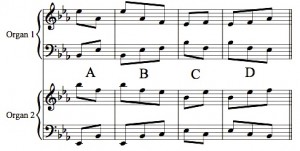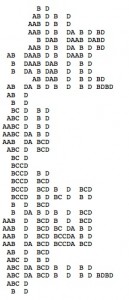A week from today and tomorrow, I’ll be in Amsterdam for the University of Amsterdam’s conference on Phil Glass’s Einstein on the Beach. I’m taking part in a panel discussion January 5, and on the morning of the 6th I’ll give a paper on my analysis of Einstein, the writing of which I am interrupting briefly to make this announcement. My interest is in the intuitive and nonlinear (right-brain) structuring of the piece’s music, which was such a departure from the process-oriented minimalism of previous years. In fact, while it’s easy to see what’s going on in the music, it’s cost me considerable thought and some ingenuity to figure out how to describe it or chart it in some clear way. For each movement (scene) I’m trying to come up with a concise graphic that will encapsulate the relevant details.
For instance, the “Building” scene is a really simple continuum of eighth-notes for two organs in a pentatonic scale, something like Music in Contrary Motion. But the musical logic is not at all linear, and is difficult to spell out. I finally realized that the music can be reduced to four modules:
Of course, the fact that module A is included in module B, and C in D, is part of the apparent micro-complexity. But I figured out I could line up all the repetitive patterns in such a way that one can tell instantly what changes from one pattern to the next (each pattern in repeat signs represented here by one line):
What logic there is becomes evident, I think. The piece begins with the two 3/8 modules (B and D), and in the first half inserts module A in various and changing places. Unlike earlier pieces such as Music in Fifths, the process isn’t additive, but sometimes jumps the added module from one place in the pattern to another. The first half expands with added A’s and then contracts down to just B and D again, and then starts adding in module A at the beginning, and introducing module C toward the end, of each repetition. Then A drops out and it concentrates on BCD for awhile, gradually moving toward an emphasis on the 10/8 pattern ABCD before reducing back to BD at the end. Of course, what one hears are mostly the irregular rhythmic accents made by the highest and lowest repeating notes.
This being a rather formal paper, I once again have the decision to make as to whether to submit it to an academic journal or just publish it here. I like the journal American Music, and have connections with it, but its articles aren’t always accessible on JSTOR, and access is the whole point. Musical Quarterly is terribly slow, taking years between submission and publication. Perspectives of New Music was the prestige music journal of my youth, but while they might publish it for variety’s sake, the editors really seem antipathetic to this kind of music; they tried to slightly sabotage my Well-Tuned Piano article 20 years ago, and I’ve never been tempted to send them anything else. So I have to weigh whether having another résumé line is worth limiting the article’s circulation. Meanwhile, I get a trip to Amsterdam out of it, and there are few places I love more.


